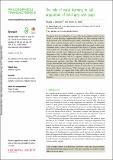The role of vocal learning in call acquisition of wild grey seal pups
Abstract
Pinnipeds have been identified as one of the best available models for the study of vocal learning. Experimental evidence for their learning skills is demonstrated with advanced copying skills, particularly in formant structure when copying human speech sounds and melodies. By contrast, almost no data are available on how learning skills are used in their own communication systems. We investigated the impact of playing modified seal sounds in a breeding colony of grey seals (Halichoerus grypus) to study how acoustic input influenced vocal development of eight pups. Sequences of two or three seal pup calls were edited so that the average peak frequency between calls in a sequence changed up or down. We found that seals copied the specific stimuli played to them and that copies became more accurate over time. The differential response of different groups showed that vocal production learning was used to achieve conformity, suggesting that geographical variation in seal calls can be caused by horizontal cultural transmission. While learning of pup calls appears to have few benefits, we suggest that it also affects the development of the adult repertoire, which may facilitate social interactions such as mate choice.
Citation
Stansbury , A & Janik , V M 2021 , ' The role of vocal learning in call acquisition of wild grey seal pups ' , Philosophical Transactions of the Royal Society. B, Biological Sciences , vol. 376 , no. 1836 , 20200251 . https://doi.org/10.1098/rstb.2020.0251
Publication
Philosophical Transactions of the Royal Society. B, Biological Sciences
Status
Peer reviewed
ISSN
0962-8436Type
Journal article
Description
This study was funded by the Natural Environment Research Council of the UK, grant no. NE/I024682/1.Collections
Items in the St Andrews Research Repository are protected by copyright, with all rights reserved, unless otherwise indicated.

